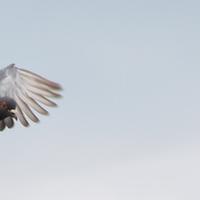
Jul 11, 2012
In our Lost & Found episode, producer Tim Howard told the story of a pigeon named G. I. Joe, an avian war hero whose astonishing navigational skills saved over 1000 lives in an Italian town after its liberation from the Nazis.
Released in wholly unfamiliar terrain, G. I. Joe soared over mountains, lakes and forests back to his home base, delivering his message just in time to thwart an aerial bombardment. 20 miles in 20 minutes. But how exactly did he do it?
During the show, crackerjack pigeon pundit Charles Walcott was our go-to bird orienteering expert, and he explained that despite decades of experimenting, no one really knows exactly how pigeons do what they do. Do the birds use smelly landmarks? Or barely audible infra-sounds? What role does their super-sensitive vision play?
Walcott's hunch is that pigeons keep from getting lost (at least partly) by using magnetism. He told us that they have magnetic iron particles in their beaks, which function like a combination compass and on-board GPS.
This magnet hypothesis sounds sensible enough, but it remains contentious among pigeon experts.
For scientists like Walcott, who want to prove the magnetism theory, there are three main puzzle pieces to lock down:
- the receptor, aka how can a pigeon actually detect a magnetic field?
- the processor, aka how does a pigeon's brain register the magnetic info picked up by its receptors?
- the map, aka how does a pigeon store "knowledge" about where it wants to go and how to get there?
Last year, the scientific consensus was that puzzle piece (1) was more or less in the bag. Based on all kinds of evidence--electron microscopy, imaging technology like MRIs, experiments on pigeons with lesions or under local anesthesia--bird physiologists had three solid leads about where to find magnetic receptors in pigeons: the retina, the inner ear, and the upper beak. And of these three spots, the beak--which is full of iron-rich cells--was a leading contender. One clutch piece of evidence was the way beak skin (sliced off with ceramic blades to avoid iron contamination) reacted to two different chemical stains (Prussian Blue and Turnbull's Blue) designed to detect two types of iron ions.
But now, one year after we first went pigeon-crazy, it turns out that bird physiologists don't necessarily know what they thought they did. There's been a full-on shake-up in the world of pigeon science.
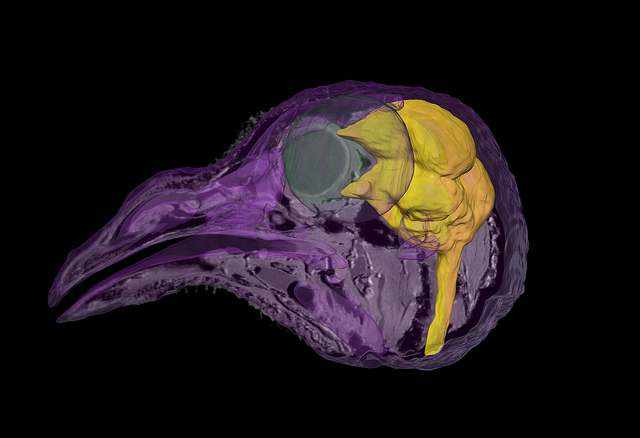
UCL Centre for Advanced Biomedical Imaging created ‘three-dimensional blueprints’ of the pigeon beak. Magnetic resonance imaging (MRI) revealed the external soft tissues (purple) and micro-computed tomography (CT) exposed dense bony structures (yellow). (M. Lythgoe, J. Riegler www.ucl.ac.uk/cabi/). Photo and captions via UCL News/flickrCC-BY-2.0
In April 2012, a flock of European and Australian researchers published an article in Nature debunking the theory that magnet-sensing receptors could be found in the upper beak.
The researchers argued that the beak cells in question weren't sensory receptors at all, but instead a kind of white blood cell called a macrophage. (The reason they were thrown? One of the macrophage's functions is to recycle iron from red blood cells.)
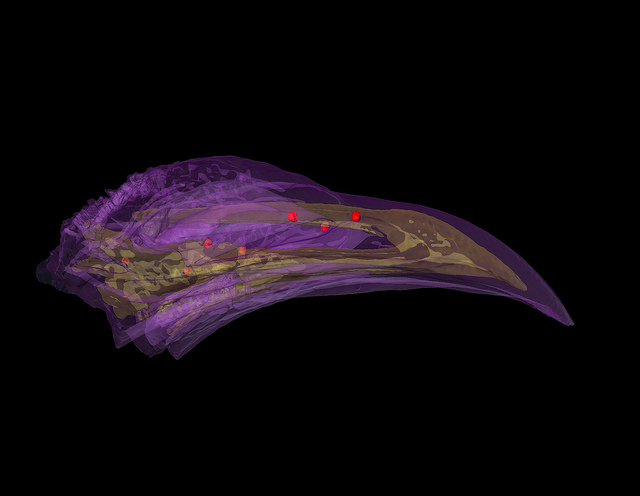
Mapping the location of iron-rich cells indicated that macrophages were filled with tiny balls of iron. (M. Lythgoe, J. Riegler www.ucl.ac.uk/cabi/). Photo and captions via UCL News/flickrCC-BY-2.0
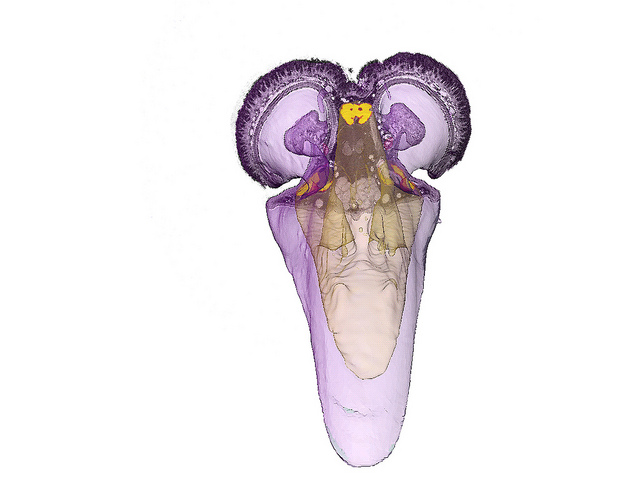
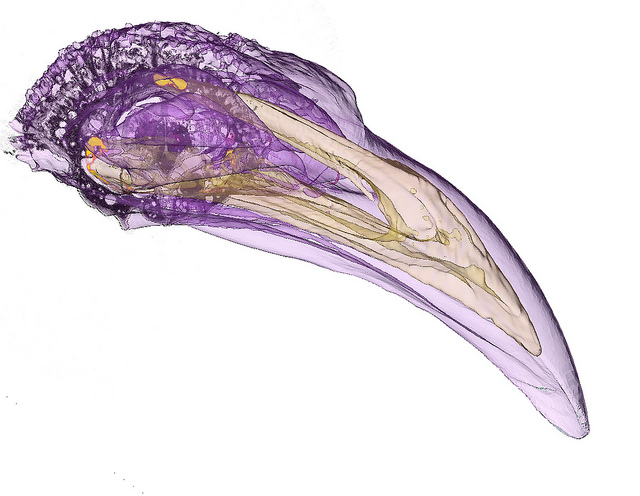
Findings revealed that the iron balls cannot produce electrical signals which could be registered by the brain, and the detailed MRI maps of the pigeon beak did not show magnetic nerves. (M. Lythgoe, J. Riegler www.ucl.ac.uk/cabi/). Photo and captions via UCL News/flickrCC-BY-2.0
The mix-up dashed the hopes of many in the magnetism camp, including the authors of the study: "our goal really was just to replicate those studies that had previously been published," the lead author David Keays said, "but unfortunately, we weren't able to do so."
Then, just a few weeks after the Nature article, things shook up yet again. This time, the new finding related to puzzle piece (2), and it was good news for the magnet school: Science reported that a team from Baylor College of Medicine in Texas discovered 53 cells in the pigeon brainstem that were indeed magnetically active. Each cell had an optimum angle that it was sensitive to, allowing it to distinguish not only the intensity of the magnetic field, but also its direction. By using that information, the authors believed pigeon brains could process magnetic signals into a "directional heading" aka a compass bearing, and a "geosurface location," aka a GPS reading.
All is not lost! Metalheads take heart!
And that brings us to (3), which seems to us to be the most difficult piece of the whole magnet puzzle: the map. Birds' brains, it turns out, are nearly as inscrutable as our own, especially outside of a laboratory. Be that as it may, many experiments and newly-devised tools seem to point to one place in particular. "There is one brain structure, namely the hippocampus," according to a 2009 review of the 'Neurobiology of the Homing Pigeon,' "that attracts attention in a peculiar way." For instance, homing pigeons have larger hippocampi than their non-homing cousins and ancestors. Or the fact that pigeons with hippocampal lesions have difficulty navigating. Or that young pigeons (squabs) allowed to fly around the loft and get experience grew bigger hippocampi (but not any other part of the brain) than their grounded counterparts. Yet there is evidence running in the opposite direction, as well; the pigeon hippocampus seems to play no role whatsoever in the geomagnetic compass, or when a pigeon is tracing a route it already seems to know by smell. The 2009 summary ends its section on the hippocampus saying that "there are still a lot of non-answered questions, unsettled details and points of discussion…" Perhaps puzzle (3) could use a little shake-up.
We wanted to know what Charles Walcott's take on all of this was, so we called him up, and as ever, he had a bird's eye view of the research. On puzzle (1), he told us how researchers' gazes have shifted from the upper beak to the inner ear. Will someone find a magnetoreceptor there? "It's a very interesting hypothesis," he said, "but until I see the neurophysiology, I'm not willing to bet the farm on it." Next, Walcott acknowledged the evidence for puzzle (2) to be "a major, major advance," a step in the right direction. As he has been since his pioneering 1979 Science article "Pigeons Have Magnets," Charles Walcott is guardedly optimistic. "We've got another piece of the puzzle," he said, "but there's lots more to go."
More on Shake-Up #1:
- Pigeons’ homing skill not down to iron-rich beak cells, University College London News
- Compass Confusion - The Pigeon's Magnetic Myth, The Naked Scientists
More on Shake-Up #2:
- Neurons in a pigeon’s brain respond to magnetic fields, Not Exactly Rocket Science
A video series hosted by Charles Walcott, about his other major research interest, yodelling loons: